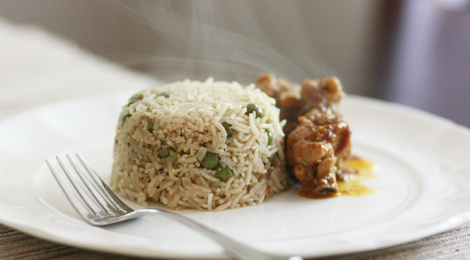
Matar Pulao or Peas Pulao
We are pulao eating folk. Hailing from Peshawar, pulao has always been a staple in our household. Unlike biryani eating folks in the south, our choice of rice, for everyday eating or for parties is always some kind of pulao. Of course now, with all different cultures mixing together, people have developed a taste for all kinds of flavors, but I still remember how my grandmother would crinkle her nose disdainfully at the sight of biryani and say “Pairee biryani!” It’s the same with my father in law who doesn’t like ‘that sweet rice dish.’ And that’s funny because biryani isn’t sweet, but since it has green cardamom which is used in every desi dessert, he tastes the sweetness by association of the aroma. Quite interesting.
Anyhow, this post isn’t about biryani bashing; I actually love biryani myself, but my point is that people from every culture are used to certain tastes, and their cuisine develops around those flavors. Because I grew up eating pulao, my first choice is always pulao. And since I make it so much, it’s easier and quicker for me. It is also the first thing that I learned to make on my own before I got married.
My mother was at work, and I called her to ask her how to make vegetable pulao. She told me the recipe on the phone and I jotted it down on my History of Design notebook. The pulao turned out almost perfect, and I have held on to that recipe like grim death! Since then, that notebook has been filled with more recipes than notes from lectures. I still have it, and use it often.
The thing about asking a good cook for a desi recipe is that they will tell you how to do it, but with desi cooking there is no hard and fast rule. If you ask me how to make ‘x’ dish today, I will tell you one way of doing it, tomorrow I might tell you another and so on.
So, when I asked my mother how to make pulao, she told me the method that first came to her mind. But because it turned out so good, I use that method for making every single kind of pulao and plain rice. I do not experiment with it, and I don’t want to. I intend on hanging on to that recipe for the rest of my life! But I doubt that my mother follows that recipe as religiously as I do!
Pulao from Peshawar means rice cooked in a meat (read beef) broth. In Lahore, where we grew up, the most common type of pulaos were chana (chickpea) pulao, chicken pulao and mattar pulao. In Peshawar, beef is the preferred choice of meat by far, and it really adds a lot of flavor to the rice. The king of pulaos, the most grand of all is the chana meva pulao; pulao made with beef, chickpeas and raisins. Another favorite, although it comes from Afghanistan, is the Kabuli pulao.
We’ll get to all those in time, IA, but I will start with the mattar pulao. I prefer to make this, especially for parties because I don’t like serving chicken/beef rice with chicken and beef and mutton and kababs and meat and meat and more meat with meat. I like the pulao to serve as a base, and give the gravies and kababs a chance to shine.
Matar Pulao
Ingredients
- 2 cups basmati rice
- 1 cup frozen peas
- 4 cups water
- ⅓ cup oil
- ½ onion, chopped or thinly sliced
- 1 tsp minced garlic
- 1 tsp minced ginger
- 2 tbsp yogurt
- 2 ¼ tsp salt
- ¼ tsp red chilli powder
- 1 tsp zeera
- 1 tsp corriander powder
- 1½ tsp garam masala OR 1 tsp black cardamom powder, ¼ tsp cinnamon powder, ¼ tsp ground cloves, ⅛ tsp crushed black peppercorns
- ¼ tsp fennel seeds
- pinch of oregano (optional)
Method
- Soak the rice in cool water for 1-2 hours.
- Fry the onions in the oil until a light golden brown.
- Add the ginger, garlic, yogurt and all the spices. Fry for a minute or two on medium heat.
- Add the peas and fry for a few minutes until all the water has evaporated.
- Add the water and give it a couple of stirs. Now taste the ‘soup’. It should be just a little too salty. Remember this taste!!! This is what the soup for your rice should always taste like, no matter how much rice you are making. When you add the rice, the extra salt will even out. Once you know this taste, you won’t need to know the exact measurement for the salt. Just make the soup taste like this every time.
- Cover and bring to a bubbling boil.
- Drain the rice and add to the boiling soup. Give it one little stir to spread the rice evenly. Do not stir the rice any further after this. Reduce the heat to medium low and partially cover the pot.
- Now you have to wait for the water to evaporate until it is level with the rice. Watch closely. Once it reaches the same level as the rice, you will first see bubbles appear on the surface, followed by holes appearing on the surface. At this point, immediately reduce the heat to the lowest low, cover the pot completely and let it cook undisturbed for 10 minutes. (I always turn on the kitchen timer) This is called dum.
- After 10 minutes, turn the heat off. The rice should be perfectly cooked. All the water should have evaporated, but the rice should not be sticking to the bottom, it should be perfectly tender but each grain should be separate.
- Simply because the water content stays for the longest at the bottom, the rice at the bottom will be slightly softer than at the top. As they will keep cooking for some time even after the heat is turned off, I like to mix the rice up a bit so that the bottom doesn’t turn into mush.
Using a rubber spatula (for a non stick pot), very carefully slide it in along the side of the pot and turn it in a folding motion, bringing the rice at the bottom up to the top. You only need to do this once or twice.
Troubleshooting
Remember, you need to watch rice closely as it cooks. If you miss the right time for dum, you still might be able to save it but it might not come out perfectly right.
Why does my rice come out hard?
You might not be using enough water, or cooking it on high heat, making it evaporate too quickly, before all the rice gets tender.
Why does my rice come out mushy?
Using too much water will make the rice mushy. A good proportion for basmati rice and water is 1:2.
Why does my rice come out sticky?
You are not using enough oil.
Why does my rice burn?
First, you need to watch it closely. Secondly, keep the heat low. Thirdly, make sure that you are using enough water.
There is still some water left, and the rice is not completely tender.
Cover it and let it cook on dum for another 5-10 minutes.
There is still some water left, but the rice is completely cooked.
Uncover and let it cook for a few minutes until the water evaporates. Then remove from the heat, fold the rice once or twice and cover, or serve.
The water has evaporated but the rice is still not completely cooked.
Throw in a handful of water and cover and cook for another few minutes on dum until cooked through.
Why is half the rice cooked and half uncooked?
The heat was too high during the initial cooking process, causing the water to evaporate too quickly and leave some of the rice uncooked. Now it’s best to just let it cook on dum until all the rice is cooked through. Add a few handfuls of water if it has completely evaporated.
Remember- the basic idea is that if the rice is not completely cooked through, then add some water and let it rest on dum until it is cooked to your liking.
Notes
The general rule of thumb for the ratio of rice to water is 1:2. But just from experience, and depending on the brand of rice you get, you might need to adjust the ratio slightly.
The color of the pulao depends on how brown your onions are. The darker the onions, the darker brown your pulao will be. Peas pulao looks more beautiful if the rice is a little lighter in color than pulaos usually are.
Our cook back in Pakistan always used to tell me to soak the rice in cool or cold water, to get the longest grain and avoid breakage during cooking.
Because pulao is best served as soon as it is cooked, it should be the last thing that you make, right before serving the food. To save time, make the soup for the rice beforehand. About 40 minutes before you’re ready to serve, bring the soup to a boil and cook the rice according to the recipe.
The other option is to make the pulao before the guests arrive and put it in the oven on the warm setting.
If you cook it too much in advance and try to warm it in the oven, it may or may not get properly warmed through and through.
When serving the rice, carefully slide your spatula in along the side of the pot and lift up. Our cook used to really yell at us if we stuck the serving spoon right in the center, and I’m the same way. It completely breaks all the beautiful grains of rice.
Please ‘like’ Zabiha Bites on Facebook.
Related Post:






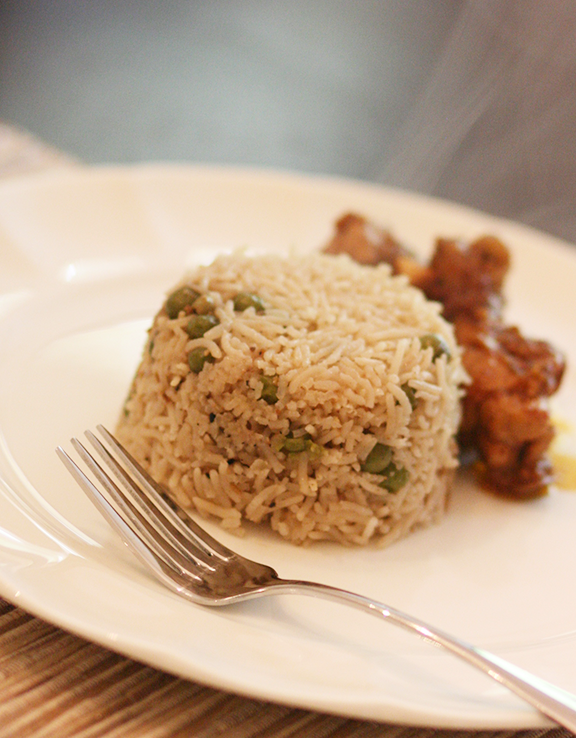
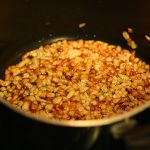
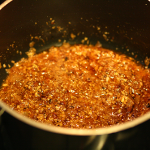
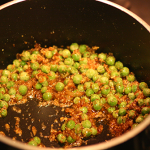
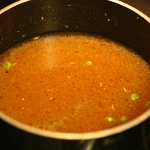
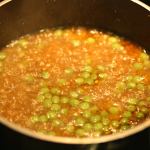
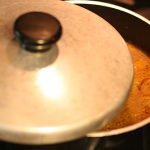

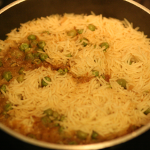

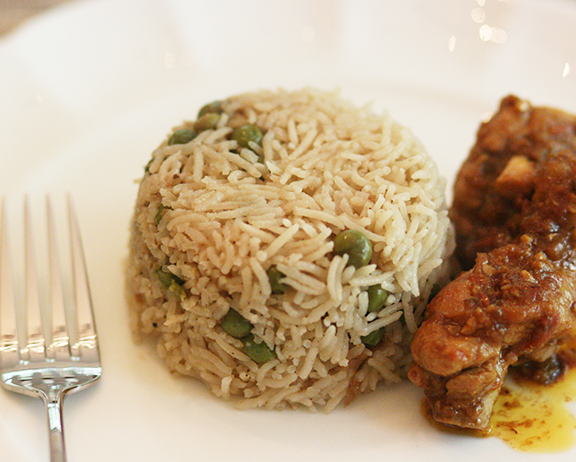
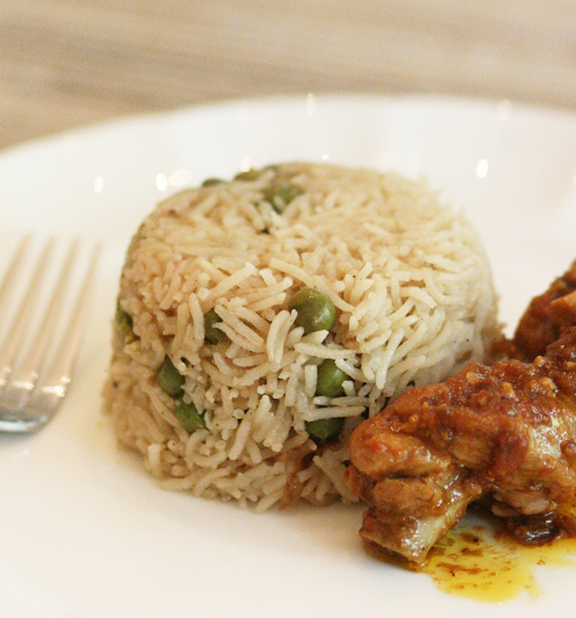
So I followed your recipe today and I must say it was incredible. MashaAllah. The detail and attention you have put into this post can be told by how my pulao came out. I always had problems with my rice, sometimes it was wet, sometimes hard, sometimes couldn’t even be salvaged. My hubby being a Karachi wale is very picky and very hard to please, but as he was eating he nodded his head and said Bohot acha bana hein. Believe me, that’s quite the compliment! JazakAllah darling for this recipe and for teaching me how I should be cooking my rice. May Allah bless you.
Thanks for stopping by! Glad you enjoyed it! Thanks for the compliments and duas.
Lol @ “pairee biryani”. Your grandmother is so cute!
Lovely photographs. Thanks for immortalizing my recipe. Love, Ammi
nice pre-recipe story. matar pulao is the best of the best. i prefer darker color. ladies, please obtain extra long rice grains and be careful turning the pulao so as not to break the rice. a truly wonderful base for any desi meal.
Beautiful pictures ! I have to pass this post on to all my hyderbadi friends so they can understand why pulao is so good. LOL
lolll
matar pulao is also my go to pulao in times of need. one sure shot way of knowing when the rice is fully cooked (i never remember to note the time) is when you first smell the aroma of basmati rice. this has saved me so many times.
also you mentioned uneven cooking, well i noticed that if the cooking pan is bigger than the circumference of the stove top especially if its electric. the rice on the periphery will be cooked less thoroughly.